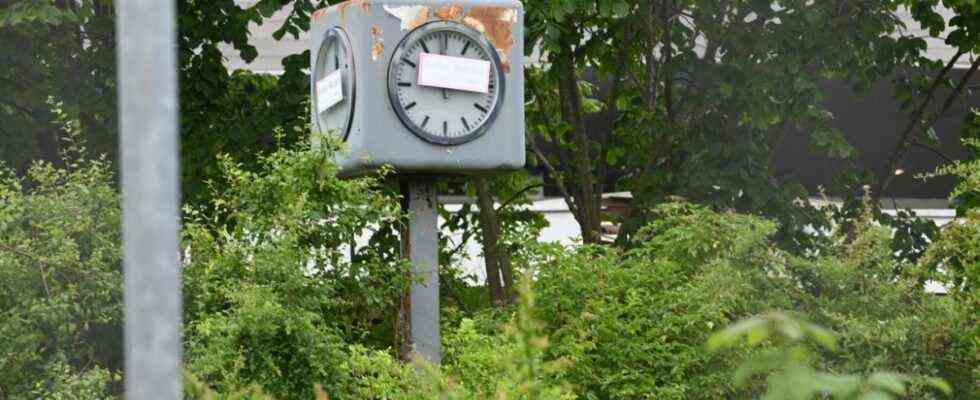Here and there grass grows out of the cracks between the cobblestones. In the middle of the site, the reversible roundabout is overgrown. A grandfather clock protrudes from between trees and bushes. Its hands are pointing to just before twelve, for years. For a very long time nothing has moved at the old Olympiazentrum bus station. For more than a decade there has been an argument about how the bus stop, which was once set up for the 1972 Olympic Games, can be used. Shortly before the 50th anniversary of the Games, things seem to be going on at the ailing train station.
“We have been waiting for 15 years for something to happen there. There was a citizens’ meeting, a round table, there should be a competition. Nothing has come of everything. It’s just a fairy tale hour,” says Erich Tomsche (CSU), deputy chairman of the District Committee (BA) Milbertshofen-Am Hart. The local politician is regularly enraged when it comes to the abandoned bus station. If he goes through the Olympic village, he will be addressed “permanently” about the site. He asked himself what his job would be as a BA member if applications to the bus station were rejected in principle.
The bus station is no longer needed because the U 3 now runs to Moosach.
(Photo: Catherina Hess)
In fact, since the bus station is no longer needed due to the extension of the U 3 to the Olympia shopping center, it has been on the agendas of the district committee again and again. Most recently, in February, the BA asked the city to explain to the residents of the district what is planned for the celebrations for 50 years of Olympia 72 on the site of the old bus station. That, in turn, was a reaction to the city’s cancellation of a BA-initiated street food festival that should have taken place this summer. The mobility department had pointed out that the roof was in need of renovation. Therefore, there is a lack of traffic safety at the stop. “Accordingly, this area is blocked and cannot be used until the European Championships 2022,” said a letter from the presentation.
The roofing of the bus stop is to be renovated in 2023. Apparently a not entirely unproblematic matter. The station was an important part of the traffic concept that the architects Behnisch & Partner and the landscape architect Günther Grzimek had devised for the 1972 Olympic site. Therefore, the roof itself is not a monument, but belongs to the protected Olympiapark ensemble, for which the city has applied for inclusion in the UNESCO World Heritage List. This does not make it impossible to convert the area around the bus stop, but the structure cannot simply be demolished. The city council decided to redesign it in 2018: the area should be visually moved closer to the park. According to these plans, a visitor center and a mobility station for electric vehicles could be built at the old bus station.
Confused ownership structure and responsibilities within the administration have caused all rescue attempts to fail.
(Photo: Catherina Hess)
In the course of this redesign, the city actually wanted to buy the site from Stadtwerke München (SWM). The municipal subsidiary confirms that a property sale “was negotiated until it was ready to be signed and fully prepared in the contract”. However, the city resigned from the purchase of the property in writing at the beginning of 2020. The municipal department responsible for the urban real estate business confirms this. “The main reasons were that it is not possible to separate the use above ground and the underground structure below,” says spokeswoman Maren Kowitz. Thus, the city would have “in fact had no design leeway of its own” on the site. The site remains with the municipal utilities, the operator of the stops at the Olympiazentrum, the Münchner Verkehrsgesellschaft (MVG), is responsible for its maintenance.
The confused ownership structure and responsibilities are evidently not conducive to a quick revitalization of the square. However, SWM has now announced that it wants to make the area around the bus station accessible to the public for the European Championships and the 50th anniversary of the Olympic Games in 2022. To do this, the broken roof is dismantled first. “As a contribution to the 50th anniversary and to the upgrading of the space in the interim phase, an art concept will be implemented by the Museum of Urban and Contemporary Art (Muca),” says SWM spokeswoman Doris Betzl. What art should be installed at the bus station is not yet ready to be decided. “A contextual reference to the 1972 Olympic Games is planned,” says Betzl. Muca co-founder Stephanie Utz also points out that the project is still in a “very early stage”. She is currently preparing the opening of the old health center on Dachauer Straße, which the Muca will use as a creative and art laboratory for five years.
All that remains is the culinary festival that the BA had wished for at the old bus station. On the part of the municipal utilities, it says: “Other uses such as the installation of food trucks are in coordination.” At least that sounds like a street food festival could take place next year. And then only a lot of grass has to grow over the cobblestones so that the bus station becomes the green portal into the Olympic Park that was once desired.

